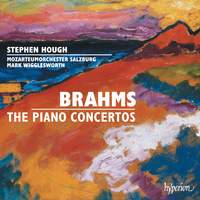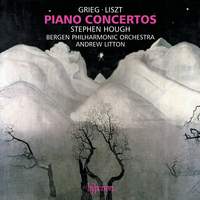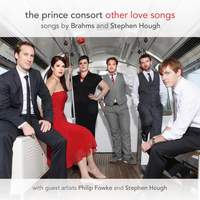Interview,
Stephen Hough on 'In the Night'
 Stephen Hough tells us a little about the concept behind his new recital-disc on Hyperion, which explores different aspects of night and dreams and includes the premiere recording of his own single-movement sonata 'notturno luminoso'.
Stephen Hough tells us a little about the concept behind his new recital-disc on Hyperion, which explores different aspects of night and dreams and includes the premiere recording of his own single-movement sonata 'notturno luminoso'.
With such a wealth of repertoire out there which is inspired by night and dreams, how did you go about narrowing down your selections for this recital? Did you start out with a clear idea of which aspects of night you wanted to explore?
>This CD came out of a concert programme I was touring a season ago. I decided to use the concept of 'nocturne' as a hook because my 2nd sonata had that title. But I didn't want it to be an all-dreamy programme of course! A friend suggested 'In the Night' as a title and so I decided to use the Schumann piece with that name as the opener.
Tell us a little about your own composition, 'notturno luminoso'...When we had a collective listening session in the office we thought we heard traces of Ravel, Debussy, Poulenc, and even Prokofiev - were you consciously influenced by any of these composers (or indeed by any of the other works on the disc)?
>The piece was not written alongside the other works on the disc; it came first and the rest was built around it. I usually take a year to write a big work so that I can think and sketch and plan and revise and rework, and so everything can marinate. This piece starts with bright chords and a melodic motive - like shards of coloured glass, or a stained window. There is something of Messiaen in some of the harmonies and also something (curiously perhaps?) of York Bowen later in the work. Much of the middle section is inspired by Stockhausen and Webern in its displacement of octave and rhythm, and the American composer George Tsontakis, whose music I have recorded, was an influence too.
The piece falls into two contrasting sections, in ABA form: how much of a narrative dimension is there at work here?
>There is no programme to the piece as such - it's just an abstract work with some nightly ghosts. There are three tonal 'colours' at work: sharps which represents openness/light; flats which represent desolation/darkness; and naturals which represent blankness/disorientation. Over 2/3s of the piece (I counted the bars!) is actually on the white notes but it's not C major because it's built from the scale beginning on B. I wanted to experiment with something which is actually atonal but is nevertheless only white notes. When you finally hear the flat material complete towards the end I was trying to create a sense of romantic despair and deliberately risking overkill when the motive repeats more and more emphatically. When this tumbles into the splattered reprise on the white notes (a Stockhausen moment) it should feel like the splutter of a sudden cold shower, as if the heating system has suddenly failed!
Did you draw on any non-musical sources of inspiration, such as visual or literary depictions of night?
>Another influence in my working on this piece was pop music. I don't go to nightclubs but I have a godson who is a DJ. I asked him when I was visiting once to play me some of the crazier, experimental stuff that was trending in clubs. There's very much a sense of that spirit in this sonata, exploring night as a time of heightened energy and experience, of loneliness - the city's lights.
'In the Night' was released on Hyperion Records on 28th April and features works by Beethoven, Chopin, Schumann and Stephen Hough.
Available Formats: CD, MP3, FLAC, Hi-Res FLAC
Related and recent recordings from Stephen Hough
Stephen Hough is joined by the Mozarteumorchester Salzburg under Mark Wigglesworth for these accounts of two pinnacles of the Romantic concerto repertoire in performances praised by The Times for Hough's 'thoughtfulness, elegance and brilliance'.
Available Formats: 2 CDs, MP3, FLAC, Hi-Res FLAC
A Gramophone Editor's Choice in 2012, this classy collection of Gallic miniatures also has something of a nocturnal subtext and includes works by Alkan, Chaminade and even (via Cortot!) JS Bach. Read Katherine's review here.
Available Formats: CD, MP3, FLAC
The Bergen Philharmonic and Andrew Litton are Hough's admirable partners on a recording which was a Building a Library Choice for the Grieg earlier this year; The Observer deemed it 'a wonderfully alert performance, mixing novel tempi with awesome technique and breathtaking, tingling tension'.
Available Formats: CD, MP3, FLAC, Hi-Res FLAC
These elegant, insouciant accounts of the Waltzes were nominated for a Gramophone Award in 2012 and were a BBC Music Magazine Choice the previous year, with The Guardian lauding Hough's 'authority and panache' and Classic FM describing it as 'an album to be savoured for years to come'.
Available Formats: CD, MP3, FLAC
Hough's Other Love Songs is paired here with Brahms's two sets of Liebeslieder Waltzes in fresh, engaging performances from this ensemble of bright young soloists, for whom the cycle was written; Hough sets texts by writers as diverse as Julian of Norwich, AE Housman, Claude McKay and St John.
Available Formats: SACD, MP3, FLAC, Hi-Res FLAC








